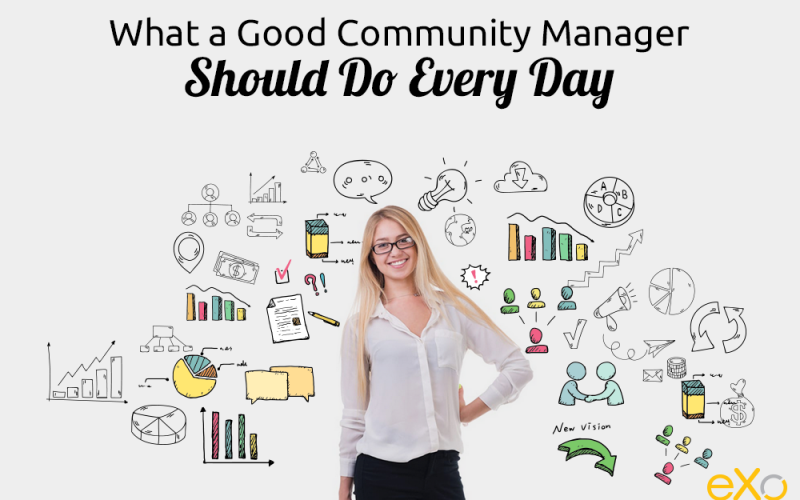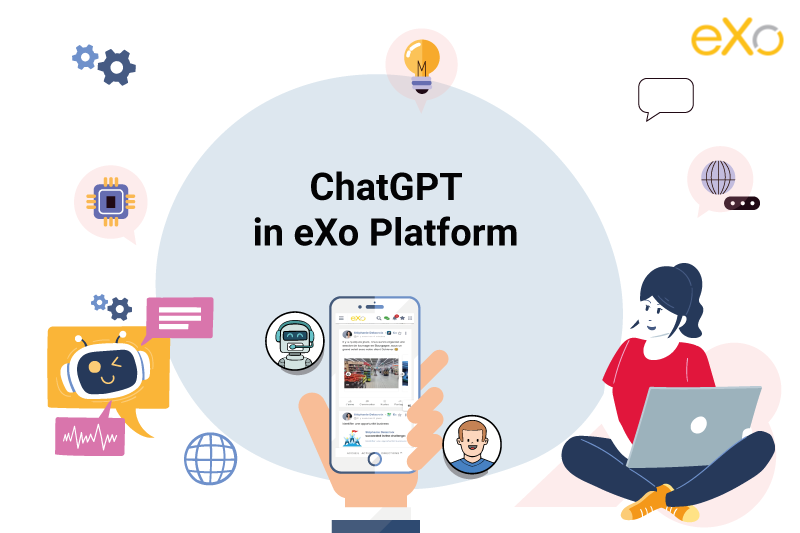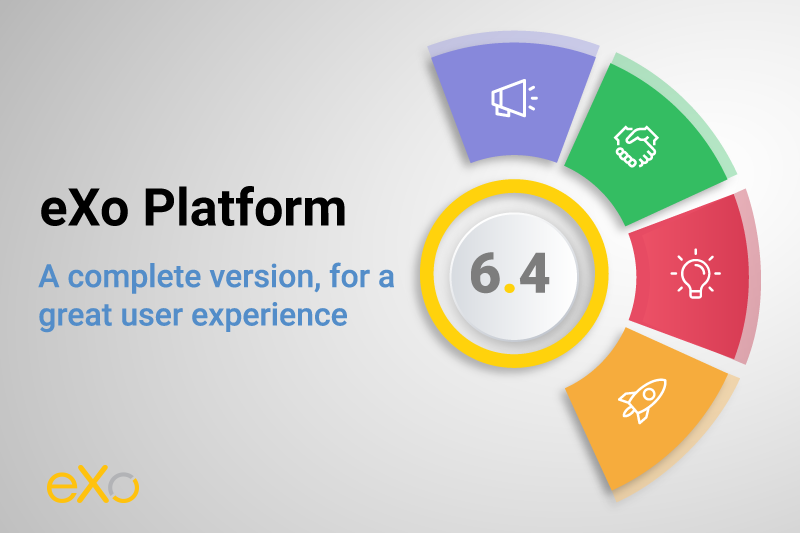- Brahim Jaouane
- May 2, 2017
4 pillars of an effective Community Manager
Getting someone to manage your online brand brings you closer to your customers, helping them trust you.
As the balance of power leans towards your consumers’ influence, they now have the power to hurt or to strengthen your online presence and your e-reputation by commenting and publishing reviews on online platforms.
This is where the community manager’s role comes in. Ensuring a strong connection between your brand and your audience is what will keep business opportunities’ flowing your way.

Content
In fact, this profession has already reached maturation, as 95% of the communities online benefit from at least part-time community management, and 75% have at least one full-time community manager, according to a survey conducted by The Community Roundtable.
I always hear people talking about community managers as people who never sleep: that to be a good community manager is to look at the position as a lifestyle rather than a job.
Google’s Davidson even says: “If you want to check in at 9 a.m. and out at 5 p.m., you’re in the wrong field. When you’ve dealt with nothing but mean-spirited comments, hundreds of emails, demanding partners and a grueling schedule of tasks — all in a 14-hour work day — you need something other than a paycheck to keep you going.”
I think we can all agree that that little extra something is passion. To be a good community manager is to love what you do daily, and to be disciplined and dedicated. Otherwise, don’t even bother pursuing this career.
I still remember when I first started in my current community manager position at a tech company about a year ago and how intimidated I was by all the tech terms and specialized topics I had never truly grasped before: social collaboration, digital workplace, open source, social intranet and so on.
I thought I could never get through it. At the time, I had always worked on simpler strategies and handled less weighty topics.
What eventually kept me going was the passion I had for this job and field. I started trying every single tactic I knew in order to figure things out and make them work.
To save you time, I have summarized a daily to-do list for a community manager along with some tips and tricks that I would like to share.
By the end of this post, you should hopefully have a clearer idea about the community manager’s role in the tech field.
So what exactly is a community manager?
Before diving deep into the community manager role, let’s establish a clear meaning for the job title from the point of view of someone who actually manages a community of people.
A community manager is someone who can manage a group of people online, and moderate and set policies for social arenas.
Creating an authentic and engaged online community is far from easy. Communities that seem to grow naturally actually flourish because of good and committed community managers.
So what exactly does an effective community manager do in order to grow these communities, enhance the activities within them, strengthen their brand awareness and contribute real value?

FREE WHITE PAPER
Daily tasks of an effective community manager
The first step is to know your voice and to learn what factors drive your community. In order to handle groups of communities, you need to understand the core mission of your company, its marketing approach, its market positioning and competition, what your company does better or worse than the others, its strengths and its pain points.
Effective community managers have to deeply understand the main objectives of the company and not just stick to generalities and superficialities.
They also have to learn a lot about the main audiences they’ll be dealing with, or what we call “user personas”. Getting to know your target demographic’s social and behavioral criteria can only help you amplify the impact of your message.
After setting clear short- and long-term objectives and drawing your target persona template, it’s then time to work on a consistent action plan.
This action plan is what will drive a community manager’s daily tasks.
For instance, if you’re working in the fashion field then you’ll focus mainly on social media outlets like YouTube, Instagram, Snapchat and Pinterest. This is where you’ll find a more qualified audience.
You’ll be working more on attractive visuals, some tips and tricks about customized clothing like men’s cocktail attire, and blog posts about where to shop and why.
This would certainly be different than a field where, for example, the main community personas you deal with are professors and PhD students and where you may want to stick more to publications such as white papers and the like.
1. Focus on your communities
Once you’ve done your homework to understand what your community is looking for and what it comprises, the next thing to do is to figure out how to position yourself within these groups.
By that I mean working on different scenarios for each community so that you can match your actions with the driving forces you managed to uncover earlier.
Remember that you’re the action-taker here – you looked for these communities and you’re aiming at positioning yourself as an expert and a trusted source so you can provide your solutions relevantly and intelligently later.
In this stage you have to think about what your top communities are and how to add value to them.
If you work in the software industry like myself, then you should already know that the most qualified members are on IT forums, Q&A websites and social media groups.
Needless to say that this is where you can obtain the most attention when and if you contribute in a helpful and intelligent way.
Spend the first few weeks after you join these communities observing and analyzing. Detect the most engaged users and work on how to get in touch with them.
The interaction has to be authentic and not forced. If you’re reading a comment or an answer in a forum or in a LinkedIn/Facebook group, don’t throw in a generic ‘Nice’ or ‘I totally agree’.
Take your time instead to elaborate a well thought out contribution. Chances are you’ll get noticed sooner than you think.
So if you’re answering a question on a Q&A website like Quora for instance, don’t push your offers or put a link directly to your pricing page.
Try to actually answer the question and provide value, and then you can mention the company you work at, what you offer along with other alternatives to your offer, so you don’t come off as a promotional.
Now you may ask how many times a week you need to do this. The answer is that this depends on your responsibilities, but you should always try to stick to a regular frequency. Don’t be hard on yourself, just be consistent.
If you can only do this twice a week then so be it. But stick to it so that you stay in your community members’ minds.
2. Harness the power of your social media channels
As social media influences purchase decisions, you need to capitalize efforts on it.
Let me share a little secret with you: if your company has just been launched then just focus on a single social media platform at the beginning.
You can expand your activities later when your company starts to grow.
Now, if your company is already established, this is where the fun begins.
After knowing your company’s objectives and your voice, it’s time to create and to adapt content for every network.
The same content might perform well on Facebook but not LinkedIn for instance. Even in the software industry every channel has its own habits and behaviors.
In general, LinkedIn is great for professional networking, B2B growth and lead generation. Facebook on the other hand, is more about funny staff and personal interactions. As for Twitter, it encourages open conversation, instantaneity and fast information sharing.
With that in mind you can create your social media content calendar and stay on top of your activity. You can either use Google Docs or opt for other alternatives such as Hubspot editorial calendar, Trello, CoSchedule and many more.
Whatever your choice is, make sure that the solution will help you stay productive.
The question then becomes, being so busy, how do you handle matters if things get out of control (and they may well do) when you have the next social media update to make every 30, 60 or 90 minutes?
Automation is the answer. Scheduling your posts ahead of time is what will help you meet your goals.
I usually use Hootsuite to do so. There are many other alternatives, though, such as Social Baker, Stacker or Buffer to schedule tweets.
I schedule my posts of the week on Monday making sure to put the right message into every channel with the right timing, and then watch the magic happen.
Of course, that doesn’t mean that every single post has to be scheduled in advance. A little bit of spontaneity is welcome sometimes, especially if it’s an office life picture or if we go out for a dinner or for a paintball match.
3. Blogging & Content
What helps me most with these two major to-dos is content. It’s a key component in every marketing function and social media sites are no exception.
That doesn’t mean that the community manager has to write all of the articles. It’s better to have multiple authors on the same blog than to have the same person to write everything.
That’s how we ensure quality, relevance and consistency of the publication.
The community manager has to manage though the content calendar and has to assure that every author delivers the article on time, that the designer creates the graphic elements according to instructions (or according to the task in my case), and that the SEO consultant reviews the content before publishing it.
With such rich content I can have a lot of fun, while optimising my time. I usually gather two blog posts that cover the same subject and turn them into an infographic or into a slideshare.
The fun part is that I can choose whatever pictures I want to illustrate a concept. Blog posts can turn into white papers and e-books, and vice versa.
It’s my job to know exactly what type of content performs best and why. Here I rely on my best friends: key metrics or KPIs (key performance indicators).
4. Marketing analyst
A successful community manager usually enjoys looking at data (without getting stuck in it) and knows how to use it to make informed decisions.
The aim is to draw actionable insights from data analysis. The best way to do this it to combine quantitative and qualitative measures.
The quantitative data includes overall reach, engagement rate, generated leads, community growth, traffic, converted leads, and son on.
Qualitative measures include individual experiments. It’s not a good sign to have 30 comments on a post if 80% of them are from unsatisfied leads.
In my case, I also analyse the data of our dedicated community site in addition to the social media and communities’ KPIs.
That being said, it’s important to always test new strategies, new types of content and new campaigns.
For instance, if you usually write a business solutions blog post to help your audience overcome challenges, maybe try a podcast next time or even a Facebook/Instagram Live Event to directly talk about the topic. Then compare the results of both actions.
This is the most effective way that any community manager can improve his/her marketing efforts and achieve more ambitious goals.
Now after reading this, you may wonder how can one person do all of this. What does it take to succeed in such a job?
Actually, there are some common traits that effective community managers should possess in order to get the things done.
What does it take to get the job done and succeed in it

Conclusion
Community management requires a lot of multitasking, skill and sticking to best practices.
If you love the job then you’ll find a way to make things happen, instead of feeling stressed and overwhelmed. The list that I shared above is by no means exhaustive: there are certainly some tasks that I haven’t mentioned.
So if you have any other tips to share, don’t hesitate to speak your mind – add them in a comment!

Related posts
- All
- eXo
- Digital workplace
- Open source
- Internal communication
- Collaboration
- News
- intranet
- Future of work
- workplace
- Knowledge management
- Employee engagement
- Employee experience
- Employee productivity
- onboarding
- Employee recognition
- Change management
- Cartoon
- Digital transformation
- Infographic
- Remote work
- Sneak Peek
- Solutions
- Thought leadership
- Tips & Tricks
- Tutorial
- Uncategorized



That is really intersting to me that 95% of online communities have someone managing them behind the scenes. For industries that require a lot of networking, this can be really beneficial. If you think you could benefit from this, it is worth considering.
Yes Kenneth. The secret is a lot of networking!
Search engine optimisation, which is usually referred to as SEO,
is the process of climbing the quantity and caliber of visitors produced
to a site or other Internet established real estate in search engines’ natural/organic ranking effects for certain words referred to key words.
This post will help the internet users for creating new
blog or even a weblog from start to end.